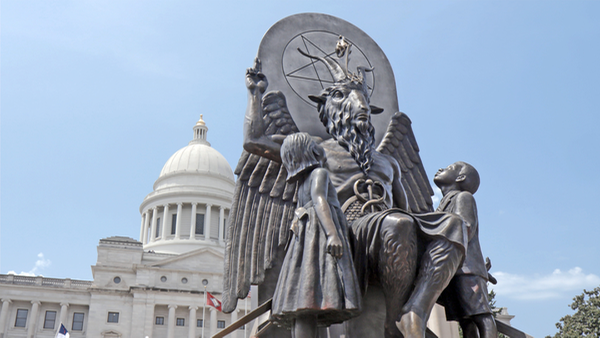Movie review by Greg Carlson
Documentarian Penny Lane adds another entertaining movie to her filmography with an inside look at the recent rise of the Satanic Temple. As a movie experience, “Hail Satan?” often lives deliciously. The film might even turn out to be a prime recruitment video for the organization co-founded in 2013 by onscreen imp/spokesperson Lucien Greaves. TST is the perfect subject for the witty and insightful Lane, who detonates truth bomb after truth bomb in a campaign to highlight the group’s unrelenting quest to expose hypocrisy and double standards and politically engage opponents of the separation of church and state. Unlike previous “devil worship” outfits, TST’s deliberate activism and community engagement far surpass the showmanship and self-promotion of Anton LaVey.
Lane’s focus on several of TST’s provocative operations takes precedence over any in-depth historical account of Satanism, but the filmmaker does make a little bit of room to consider the so-called Satanic Panic of the 1980s, in which hysteria over purported ritual Satanic abuse and deep fear of the occult destroyed the lives of innocent people wrongfully accused of molesting children in their care. The most well-known example, the McMartin preschool trial, has been deconstructed elsewhere, but Lane effectively contextualizes the phantom conspiracies that scapegoated everything from Dungeons and Dragons to Motley Crue and other heavy metal acts that could be unmasked by playing their records backwards.
And speaking of goats, Lane squeezes every drop of blood from TST’s battle to bring the towering statue of Baphomet to the same public spheres occupied by Ten Commandments monuments in Oklahoma and Arkansas. Based on the illustration by Eliphas Levi, the striking 3000-pound bronze by sculptor Mark Porter quickly became the primary symbol uniting those who would challenge the likes of Tea Party conservative Jason Rapert, who serves District 35 in the Arkansas State Senate. A walking caricature, Rapert makes for a broad villain based on his sponsorship of a bill allowing for a stone marker similar to the ones popularized by Hollywood producer Cecil B. DeMille in a publicity stunt to drum up ticket sales for the 1956 Charlton Heston movie.
Lane also introduces viewers to a rainbow range of adherents and admirers of the dark side, using their many personal anecdotes to explain the appeal of the group. Especially savvy is the presentation of TST’s seven fundamental tenets, a list of logical, humanist principles that give the Old Testament laws a run for their money. But can the center hold in an organization given to the aggressive questioning of authority and the demonizing of hierarchy? Detroit’s Jex Blackmore partially answers that question, splintering from TST following disagreements over policy in performance art pieces too radical for Greaves and the central leadership.
Blackmore’s breakaway brand of Satanism could fill another feature, but Lane keeps her eye on TST’s media spotlight actions. While the Baphomet sequences dominate, viewers also bear witness to several of the group’s more curious pieces of political theater, from the innocuous (an adopt-a-highway clean-up) to the eyebrow-raising (After School Satan) to the deliberately scandalous (the ribald Pink Mass, teabagging and all, held at the gravesite of the mother of Westboro Baptist figurehead Fred Phelps). Viewers new to TST’s approach to the headline-grabbing values of blasphemy will surely be surprised that members do not worship any incarnation of an anthropomorphic, horned, pitchfork-wielding manifestation of evil, but instead use the iconography to satirize all manner of injustice, folly, and corruption.
